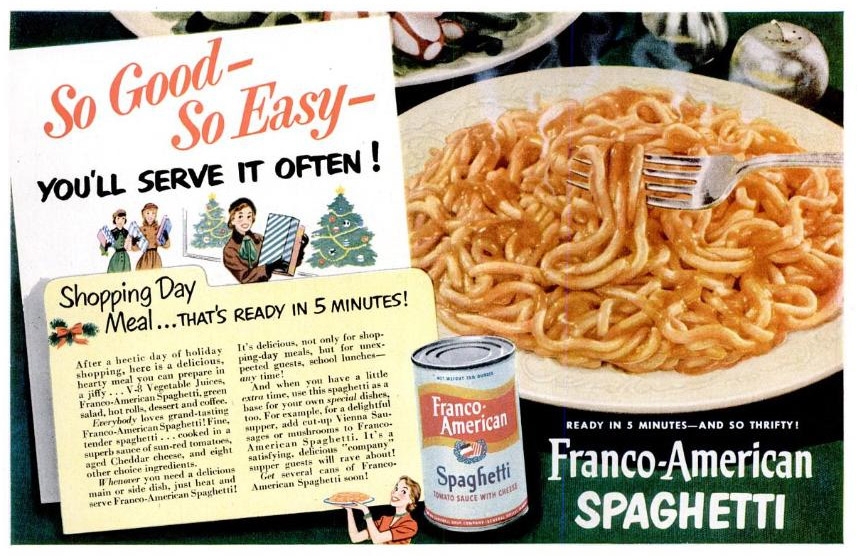In Jersey City, where I went to school until fifth grade, we came home for lunch. My mother had grown up with cooks but was of a postwar generation of privileged women who prided themselves on doing their own cooking, a rebellion against their mothers’ feudal dependence on kitchen help – their small revolution was eventually aided by the introduction of dishwashers, Waring blenders, and the like. My mother’s lunches were utilitarian – Franco-American Spaghetti which came in a can, tuna fish salad on Wonder Bread, iceberg lettuce.
Once a week, when my parents went to New York on their “day off,” Agnes Weickert, whom we called “Gagy” and who was Norwegian, came to take care of us. She made much better lunches – my favorite was something she called “an egg pancake,” crepe-thin, all egg and cooked in a cast iron skillet, not turned but folded when done. She also introduced me to the pleasures of spinach: while my mother threw frozen spinach in boiling water, Gagy chopped the fresh leaves and creamed it. She taught me how to make a roux, and more important, how to flavor it with just the right amount of salt and pepper – the pepper was key.
At the time I thought my mother was constitutionally a bad cook, but now I realize that in Jersey City, she was a working mother. She was part of the team, along with my father and two other Episcopal priests, who ran the inner city parish and all its mission projects. She didn’t have time to cook for us—she had to keep soup on the stove for the homeless men who came to the door, supervise the women’s club, the girls’ club, and call on families in the neighborhood, “a baby under one arm, cabbage in the other!” a 95 year old woman who had known her recently told me. She also continually read, books, the New York Times, the Saturday Review, the Catholic Worker and the Village Voice.
In 1957 we moved to Indianapolis, where my father was dean of a cathedral. He commuted to his office from the enormous house the church gave the dean and his family. It was in this house that my mother joined the 1950s, becoming what we now call a “stay at home mom,” the transition compelled not least by the islanded kitchen with its matching beige fake wood cabinets, its double wall ovens, its formica surfaces and electric burners embedded in the counter across from the refrigerator. Because of my father’s new position and because we were now a family with seven children, my parents decided to hire a cook. Mrs. Pendleton, a middle-aged African American woman who wore a white uniform, cooked well, but my mother soon realized that she hated being banished from her own kitchen. Mrs. Pendleton left and my mother set her mind to cooking seriously.
Jersey City had been a kind of commune, a gang for supper each night, and simple fare, enough for everyone. But in Indianapolis she was the wife of the dean. She would be giving dinner parties, and feeding a mob of children. The two babies were one thing, the five who came home from school at lunchtime were another. How to manage? She bought a freezer and began to buy in bulk, hamburger patties and hotdogs and their appropriate rolls; she and Mrs. Lee, who cleaned and took care of the “middles” and “teenies”, deployed our lunches from a wall oven set to broil as we sat crowded into the adjacent plastic-upholstered, formica-tabled breakfast nook. My mother’s lunch masterpiece was something she called a “cheese dream,” an open-face sandwich made with orange cheddar. She toasted the Pepperidge Farm bread first, buttered it, and laid on the cheese. I loved to jump up and peek through the oven window and watch the cheese dreams cook – six or eight to a cookie sheet. Take them out too soon and some of the cheese would still be hard; too late and it would be too brown and too crisp. Perfect was a condition I call “just about to bubble.” Was adding paprika my idea or my mother’s?
The Indianapolis years made my mother a great cook. The dish I really remember was crème brûlée, which she never made for family suppers and certainly never for a school lunch. The layer of broiled sugar on top was more a lid than a glaze, so it was possible for me to lift it and spoon out the custard from underneath – without leaving evidence, I could taste part of the world my mother considered adult. By the time I was an adult, my father had become a bishop and the family lived in Washington DC; the era was just after Kennedy’s assassination and my parents’ dinner party guest lists were often a glamorous mixture of their friends who were apt to be liberal journalists, peace and civil rights activists, and Cleveland Park neighbors. I never went to one of those fancy dinners, but she still made cheese dreams when the kids came home for lunch.
I moved to New York and then in with my boyfriend; we had an apartment in New York and a weekend house, and my mother sent me a source of recipes she’d just discovered, the gourmet newsletter Craig Claiborne published after he retired as food editor of The New York Times. I remember being on the phone with her the morning after I’d cooked a spaghetti Amatriciana or Maryland corn beignets, talking about what I might do next. When Claiborne announced the newest French gadget, the salad spinner, in 1971, my mother sent me one posthaste. “You can’t believe how dry the lettuce gets!” The brand was Peugeot, like the car. My mother died in 1973, but the salad spinner lasted until I sold the Connecticut house in 2001.
It’s September and I’m back at school. The days I teach, I get to work at 4 pm and teach at eight. How to eat? I’m not going to warm up ramen, the present-day equivalent of Franco-American Spaghetti, and you can’t make a cheese dream in a microwave. I do like the odd sandwiches that they make at the Brazillian inspired coffee bar at the corner of 12th Street, and I can always race down to Citarella for soup or salad. I recently learned that on those days off when Gagy made egg pancakes in our Jersey City kitchen, my mother took a course at the New School. I think the class was some kind of philosophy, or maybe Spanish literature, but I have no idea what she had for lunch.
 Honor Moore’s most recent book is The Bishop’s Daughter, a memoir, a finalist for the National Book Critics Circle Award and a Los Angeles Times Favorite Book of the Year and her most recent collection of poems, Red Shoes. Her work has appeared in The New Yorker, The Paris Review, The American Scholar, Salmagundi, The New Republic, Freeman’s and many other journals and anthologies. For the Library of America, she edited Amy Lowell: Selected Poems and Poems from the Women’s Movement, an Oprah summer readings pick which is featured in the current documentary about American feminism, “She’s Beautiful When She’s Angry.” She has been poet in residence at Wesleyan and the University of Richmond, visiting professor at the Columbia School of the Arts and three times the Visiting Distinguished Writer in the Nonfiction Writing Program at the University of Iowa. When she was still in her twenties, Mourning Pictures, her play in poetry about her mother’s death, was produced on Broadway and won her a fellowship from the New York State Council on the Arts. The White Blackbird, A Life of the Painter Margarett Sargent by Her Granddaughter, published in 1996 and just reissued, was a New York Times Notable Book. She lives and writes in New York where she is on the graduate writing faculty of the New School.
Honor Moore’s most recent book is The Bishop’s Daughter, a memoir, a finalist for the National Book Critics Circle Award and a Los Angeles Times Favorite Book of the Year and her most recent collection of poems, Red Shoes. Her work has appeared in The New Yorker, The Paris Review, The American Scholar, Salmagundi, The New Republic, Freeman’s and many other journals and anthologies. For the Library of America, she edited Amy Lowell: Selected Poems and Poems from the Women’s Movement, an Oprah summer readings pick which is featured in the current documentary about American feminism, “She’s Beautiful When She’s Angry.” She has been poet in residence at Wesleyan and the University of Richmond, visiting professor at the Columbia School of the Arts and three times the Visiting Distinguished Writer in the Nonfiction Writing Program at the University of Iowa. When she was still in her twenties, Mourning Pictures, her play in poetry about her mother’s death, was produced on Broadway and won her a fellowship from the New York State Council on the Arts. The White Blackbird, A Life of the Painter Margarett Sargent by Her Granddaughter, published in 1996 and just reissued, was a New York Times Notable Book. She lives and writes in New York where she is on the graduate writing faculty of the New School.
featured image via The Gentleman from Indiana.


Comments are closed.